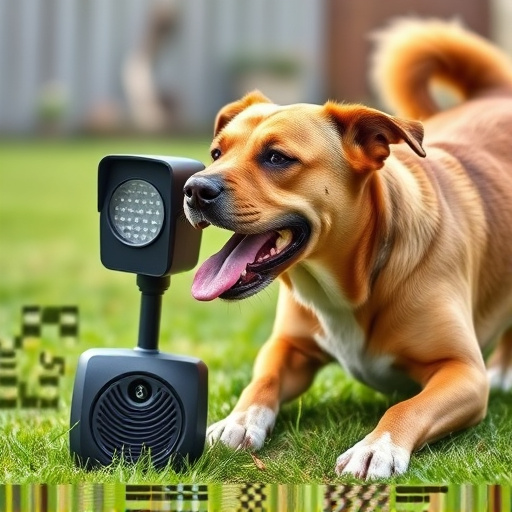Dog aggression in public spaces is addressed by FDA-approved dog repellent devices, using sound frequencies or mild electrical stimuli to calm dogs. These innovative tools, including ultrasonic emitters and smart sensors, are regulated for safety and effectiveness. Proper implementation, training, and regular checks ensure these devices prevent aggression without causing fear or stress, promoting harmony between pets, owners, and communities. Always select FDA-approved dog repellent devices for optimal results.
In many urban settings, aggressive dog behavior poses significant challenges. Traditional deterrents often fall short, sparking concern for both animal welfare and public safety. This article explores a novel solution: FDA Approved Dog Repellent Devices. We delve into the causes of canine aggression, dissecting the rise of electronic deterrents as a safer alternative. Understanding their functionality, implementation, and training is crucial to harnessing their potential while ensuring ethical treatment of animals.
- Understanding Dog Aggression and Its Impact
- The Rise of Electronic Dog Deterrents: A Safe Alternative?
- FDA Approval Process for Dog Repellent Devices
- How Do These Devices Work? Unraveling the Technology
- Implementing and Training: Ensuring Effectiveness and Animal Welfare
Understanding Dog Aggression and Its Impact
Dog aggression can stem from various factors, including fear, territorial behavior, or past traumatic experiences. When a dog feels threatened, it may react with barking, growling, or even attacking, which can be alarming for both pet owners and passersby. This behavior not only disrupts peaceful neighborhoods but also poses potential hazards in public spaces.
Fortunately, FDA-approved dog repellent devices offer a safe and effective solution to manage and deter aggressive canine behaviors. These electronic devices utilize specific sound frequencies, ultrasonic waves, or harmless electrical stimuli to encourage dogs to remain calm and avoid triggering aggressive responses. By employing these modern technologies, pet owners can ensure the well-being of their pets and the safety of those around them, fostering a more harmonious environment for all.
The Rise of Electronic Dog Deterrents: A Safe Alternative?
In recent years, there’s been a growing trend towards electronic dog deterrent solutions, offering a perceived safer alternative to traditional repellents. These FDA-approved dog repellent devices operate on the principle of emitting ultrasonic sounds or vibrotactile signals that are unpleasant to dogs, encouraging them to stay away from specific areas. As pet owners become increasingly concerned about the potential harm caused by chemical or noise pollution, these innovative solutions present a compelling option.
However, while electronic deterrents are marketed as humane and environmentally friendly, their effectiveness remains a topic of debate. Studies show mixed results, with some dogs showing no aversion to these devices, while others may only learn to ignore them. Moreover, the safety of prolonged exposure to ultrasonic frequencies is still under scrutiny, raising questions about their long-term impact on dogs’ hearing and overall well-being.
FDA Approval Process for Dog Repellent Devices
The development and marketing of electronic dog deterrent solutions, such as collars or mats, are heavily regulated to ensure safety and efficacy. One of the key milestones for any manufacturer is navigating the FDA Approval Process for Dog Repellent Devices. This process involves rigorous testing and evaluation by the U.S. Food and Drug Administration (FDA) to verify that the device is both safe and effective in deterring aggressive dog behavior.
Manufacturers must submit detailed data on product composition, usage instructions, and potential side effects for thorough review. The FDA assesses the safety of the materials used, analyzes the technology behind the device, and evaluates its overall performance based on clinical trials. Only after meeting these stringent criteria can a dog repellent device earn the coveted FDA approval label, ensuring consumers that it is safe and reliable for use on their pets.
How Do These Devices Work? Unraveling the Technology
These innovative electronic dog deterrent solutions leverage cutting-edge technology to offer a safe and effective alternative to traditional, potentially harmful methods. At their core, they utilize specific frequencies or sounds that are unpleasant to dogs but often imperceptible to humans. This approach is not only humane but also backed by the FDA approval for dog repellent devices, ensuring consumer safety and confidence.
The technology behind these devices can vary, from ultrasonic emitters that produce high-frequency sound waves beyond human hearing to pulse technologies that stimulate a dog’s natural aversion response. Some advanced models even incorporate smart sensors that detect movement or vibration, activating only when necessary, thereby conserving battery life and minimizing environmental impact. This modern approach to pet management reflects a growing trend towards humane, technology-driven solutions in various fields.
Implementing and Training: Ensuring Effectiveness and Animal Welfare
Implementing and training are crucial steps in ensuring that an aggressive dog deterrent electronic solution is both effective and humane. It’s essential to follow manufacturer guidelines meticulously, as these devices often require specific settings adjustments for optimal performance while minimizing animal distress. Regular, consistent training sessions with your dog are vital. This involves positive reinforcement for good behavior and brief, targeted exposures to the deterrent stimulus under controlled conditions.
The goal is to teach your dog to associate certain environments or triggers with a neutral response, preventing aggressive reactions without causing undue fear or stress. Additionally, always choose FDA-approved dog repellent devices to guarantee their safety and effectiveness. Regular checks and adjustments are necessary as dogs adapt, ensuring the system remains a safe and reliable deterrent while promoting positive behavior modification.
Electronic dog deterrent solutions, especially those FDA-approved, offer a safe and effective alternative for managing aggressive behavior. By understanding canine aggression and leveraging advanced technology, these devices provide a humane way to protect both humans and animals. When implemented correctly, with proper training, they can revolutionize the way we address dog aggression, fostering safer interactions in various settings. For pet owners and professionals alike, FDA-approved dog repellent devices represent a significant step forward in responsible, effective animal management.
